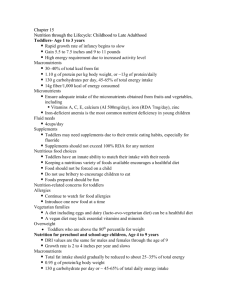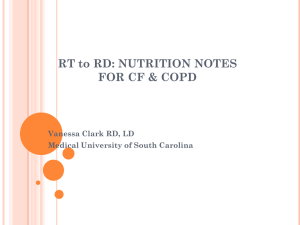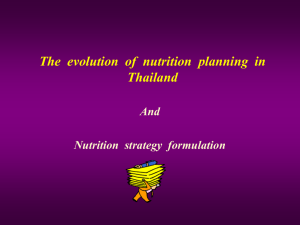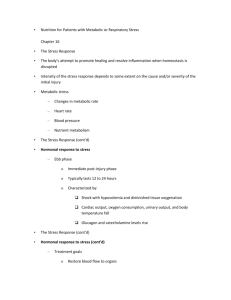Respiratory System
advertisement
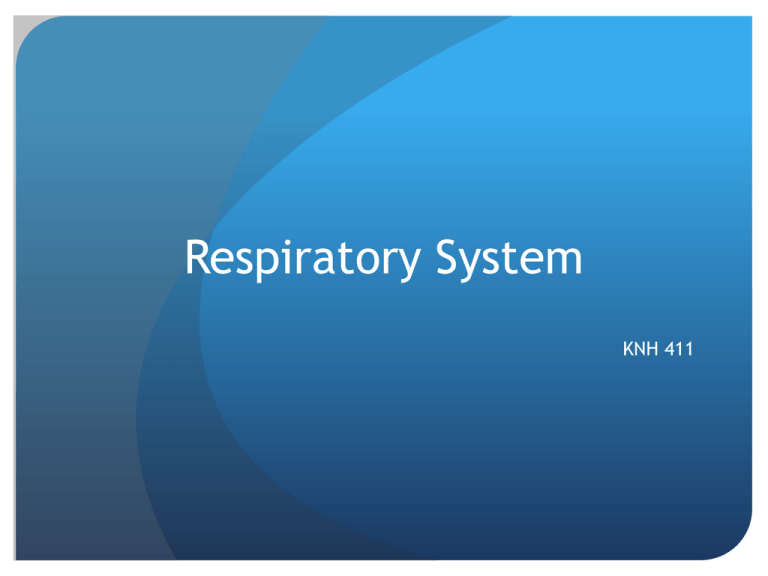
Respiratory System KNH 411 Respiratory System Nutritional status and pulmonary function are interdependent Macronutrients fueled using oxygen and carbon dioxide Malnutrition can evolve from pulmonary disorders And can contribute to declining pulmonary status Nutrition and Pulmonary Health Protein-energy malnutrition Chronic obstructive pulmonary disease patients Protein for calories, protein for rebuilding tissue: concerns the strength and endurance Antioxidants and lung function Vitamin C Vitamin E Beta Carotene Selenium Cigarette smokers Increased intake of vitamin C- DRI + 35 mg per day Usually have extremely low intake of fiber and antioxidants Early satiety, anorexia, weight loss, cough, dyspnea during eating Weight history Nutrient intake Drug interaction Biochemical markers to see where this client is in there stage Albumin, pre albumin (shorter term, over days) Bronchopulmonary Dysplasia (BPD) Growth failure d/t decreased nutrient intake, increased requirements, hypoxemia, delayed skeletal mineralization and osteopenia Lungs not fully developed-compromised breathing b/c of immaturity of the lungs Growth failure due to increased nutrient intake A lot of these babies have refluz, their spincheters arent fully developed and they will reflux during feeding Increase it up to calroies per ounce – add calroies to mothers milk Bronchopulmonary Dysplasia (BPD) Treatment/Nutrition Therapy Energy and macronutrient needs: 15-20% higher b/c of increased oxygen needs They have an increased resting metabollic weight 120-130 kcal/kg/day or higher Protein 3-4 g/kg/day Vitamins and minerals Vitamin A 1500-2800 Ius Mothers milk is normally supplemented with this amount in the hospital setting Closely monitor electrolyte balance- anywhere from 100-200 cc per kilo? Sufficient minerals for bone growth Bronchopulmonary Dysplasia (BPD) Treatment/Nutrition Therapy Mechanical ventilation Nutrition support May need fluid and sodium restriction Specialty infant formulas High calcium high phosphorus Want immune properties that are high in mothers milk Breast milk preferred Best cased scenario is a mother pumping milk and then we are supplementing it with excess nutrients Education and support to caregivers Infant born prematurely Steroids may be used © 2007 Thomson - Wadsworth Chronic Obstructive Pulmonary Disease COPD – progressive disease which limits airflow through inflammation of bronchial tubes (bronchitis) Damage could be 2 fold Obstruction of air to the bronchial tubes Or destruction of the alveoli- or a combination of both: primary concern is lifestyle Conerns Low energy intake: do to energy itself Decreased appetitie– may be due to depression Altered taste perception– b/c of chronic mouth breathing Might have increased inflmmation of that indiciudal Primary risk factor – smoking COPD Nutrition Therapy Low dietary intake Altered taste perceptions and appetite Elevated REE COPD Nutrition Therapy - Interventions Maintain optimal energy balance Maintain body weight Anywhere from 125-156% of their energy needs above BEE (basal energy expenditure) add 25-35% to 1.5 X the harris Benedict equation Protein about 20% hgih 1.7-1.2 g per kilo Overfeeding concern with ventilation Glucose >5 mg/kg/min increases CO2 production Commercial formulas - low CHO (30%) and higher lipid (50%) COPD Nutrition Therapy - Interventions Supplement antioxidants Monitor serum phosphate Monitor status of calcium and vit. D Ca 1200-1500 Vit D 400 IU of vitamin D Identify specific nutrition problems Manage weight Cystic Fibrosis Nutrition Poor digestion, absorption, malnutrition d/t pancreatic insufficiency Abnormal growth Poor growth is one of the main concerns Energy needs are sufficiently increasced Risk for osteopenia and osteoporosis Malapsorption of calcium, phosphorus, vit d , K Use steroids to decrease inflammation Impaired bone growth and brittle bones Vitamin d and vitamin K Cystic Fibrosis Nutrition Assessment Diagnosed from birth-12 months of age (usually have stunted growth) National CF Foundation consensus guidelines - nutrition guidelines Special attention to poor growth: During th efirst 12 months after diagnosis you want to focus on growth and status Use growth charts – CDC Cystic Fibrosis Pancreatic enzyme therapy Given with food and beverages Individualized Adequate kcal for normal growth based on weight gain patterns Higher fat intake (35-45% kcal) MCT-medium chain triglycerides Add liquid form to babies formula to boost up the babies calroies Normally baby formula is 20 kcal per oz 6-12 carbons long--- shorter than regular triglycerides Water soluble so require less bile– good for individuals for fat malabsorbing Glucose intolerance common Usually they will convert to a diabetic in their teen years Cystic Fibrosis Monitor vitamin & mineral status Monitor sodium levels Assess iron and zinc status Recommend breast feeding Immune fighting properties/of higher calorie Developmentally appropriate recommendations Formulas or nutritional supplements Respiratory Failure Nutrition Meet nutrition needs Trying to reserve lean body mass, particularly we are looking at respiratory muscle Energy needs vary widely; may be hypermetabolic Avoid overfeeding Can cause compromised respiratory function Indirect calorimetry preferred method Specifically looking at calorie needs 25 kcal per kilo to try to calculate needs or 130% of REE Preserve and restore LBM; respiratory muscle mass Respiratory Failure Nutrition Maintain fluid balance Facilitate weaning from ventilation Specialty formulas available EPA and GLA can reduce severity of inflammation Supplementation with antioxidants Phosphate supplementation




